Categories > Guides and Tips
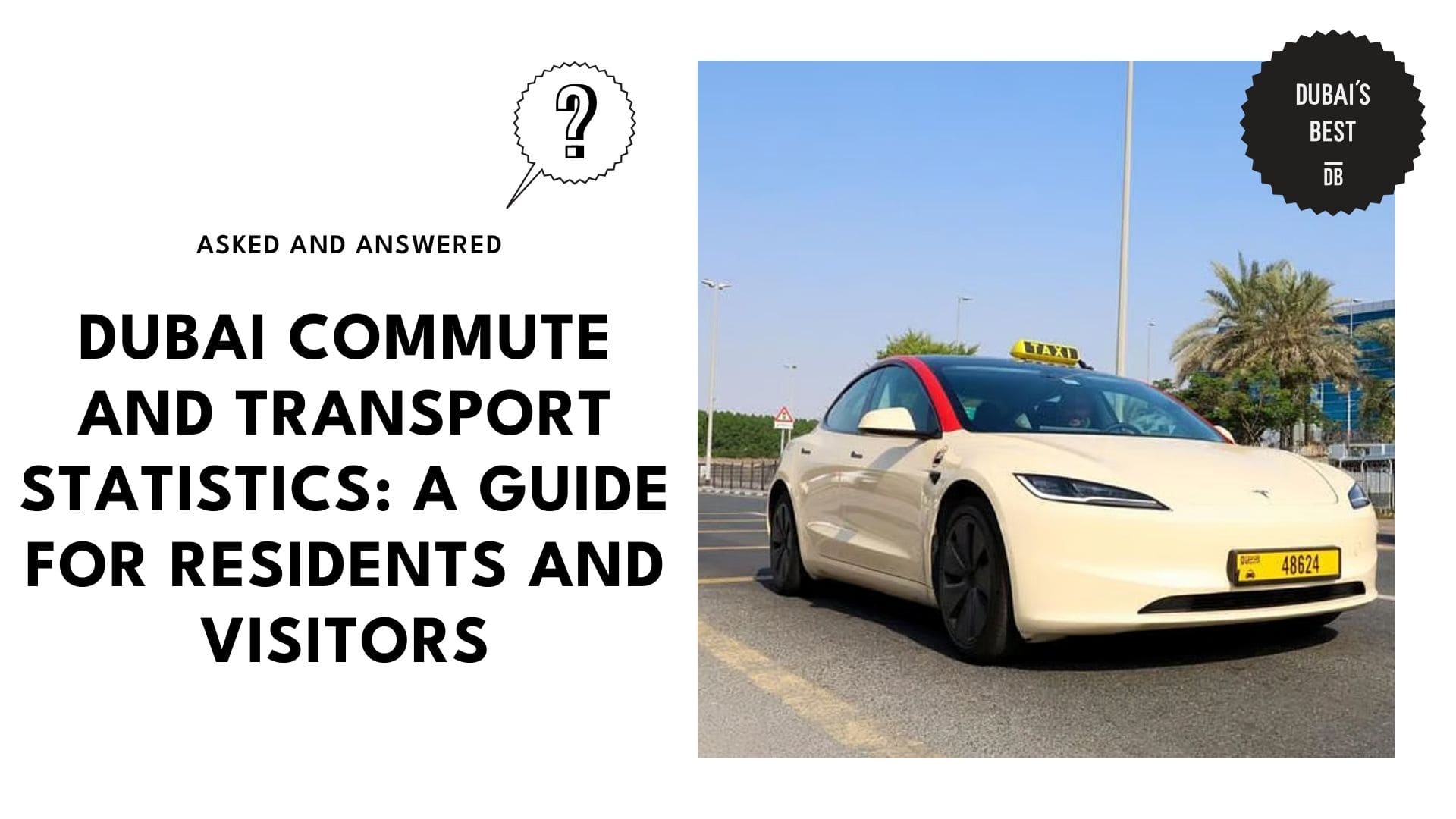
Guide to Dubai Commute and Transport Statistics for Residents and Visitors
Key Insights
| In 2023, public transport in Dubai transported over half a billion passengers, with the metro being used by 260 million of them, making it the most used mode of public transport. Dubai commuters spend 1 hour and 45 minutes daily in traffic, as compared to an average of 15-29 minutes in the UAE and 30 minutes globally. Car ownership is at 67% of residents, with only 21% of residents using public transport. This worsens the problem of road congestion. The number of registered cars in Dubai climbed from 1.9M in 2021 to 2.27M in 2023, indicating increased dependence on cars. Plans to convert a taxi fleet into 100% eco-friendly vehicles are in place with Dubai’s RTA by the year 2027, while plans to replace the entire public bus fleet with zero-emission buses are set up by 2050. Dubai’s EVs went from 15, 100 units in 2022 to 25, 929 in 2023, thereby best in the region towards adopting EV. Public transport ridership stood at 503.3 million in 2023, showing increasing reliance of commuters on the system. |
Dubai’s transport mode is a modern blend of traditional travel systems run by the RTA. Metros, buses, taxis, water transport, and monorails are included and amounted to over 500 million passengers in the year 2023.
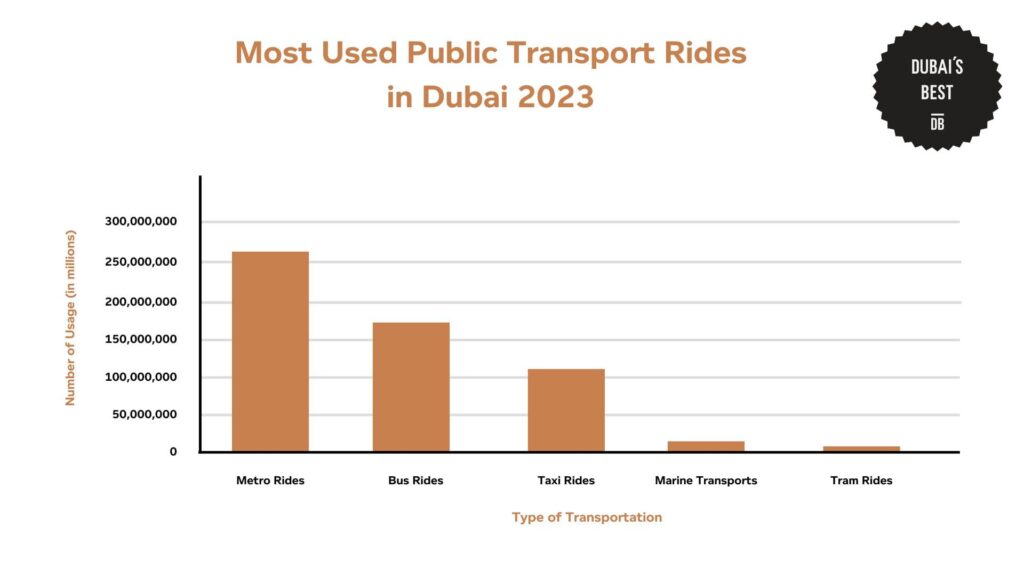
The Dubai Metro is the most popular, having 260 million riders in 2023, has 119 internal bus lines, and has 35 metro-linked routes. The Palm Monorail offers beautiful rides on Palm Jumeirah to promote travel.
Taxis and their fleets are very diverse, which includes women’s taxis and electric vehicles as well. Water transport like abras and water taxis is meant to facilitate movement across Dubai Creek.
This is not unexpected as the roads invested in would still not make traffic jams go away. Smart solutions like Smart Drive Application and Makani system were meant to further improve navigation, so transport in Dubai keeps being modernized.
Key Statistics on Commuting in Dubai
Dubai traffic jams are a great concern as they have shifted commute times beyond global standards. The average commute from most cities average around 30 minutes, while in Dubai, these professionals spend around 1 hour and 45 minutes-daily travel time.
Car dependence is one major reason for it. Many prefer driving rather than using the strong metro system in the area. Increasing number of vehicles thus keeps jamming the roads especially during peak hours.
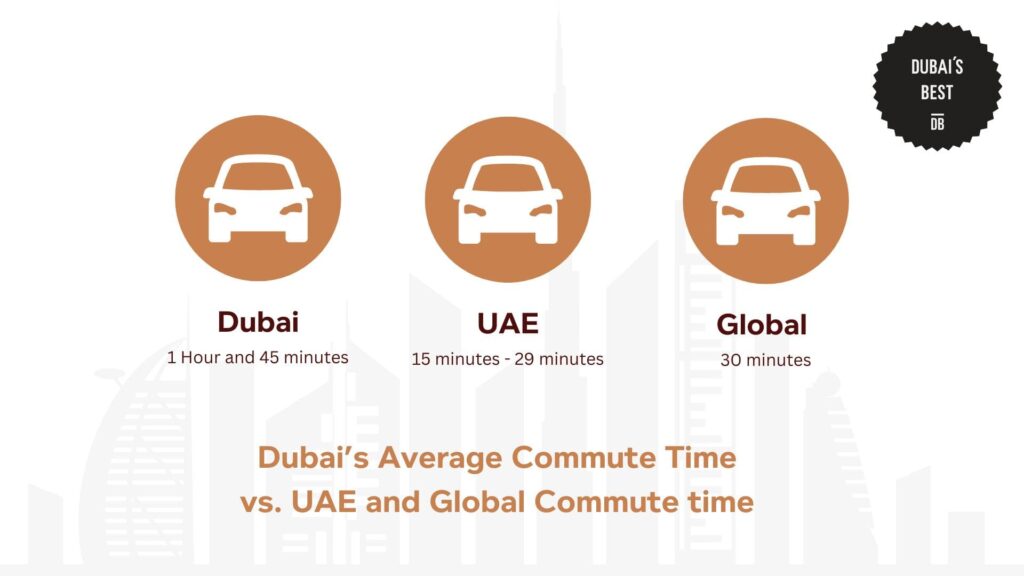
New survey reveals that 42% of Emiratis commute between a maximum range of 15 to 29 minutes, and in some cases, people would even spend shorter commute times. The situation seems different, however, for professionals who work from home at busy business hubs where their commuting times differ from the population.
It is surprising to note that though there is a strong metro system available in the country, still 67% residents own a car, and only 21% use public transport.
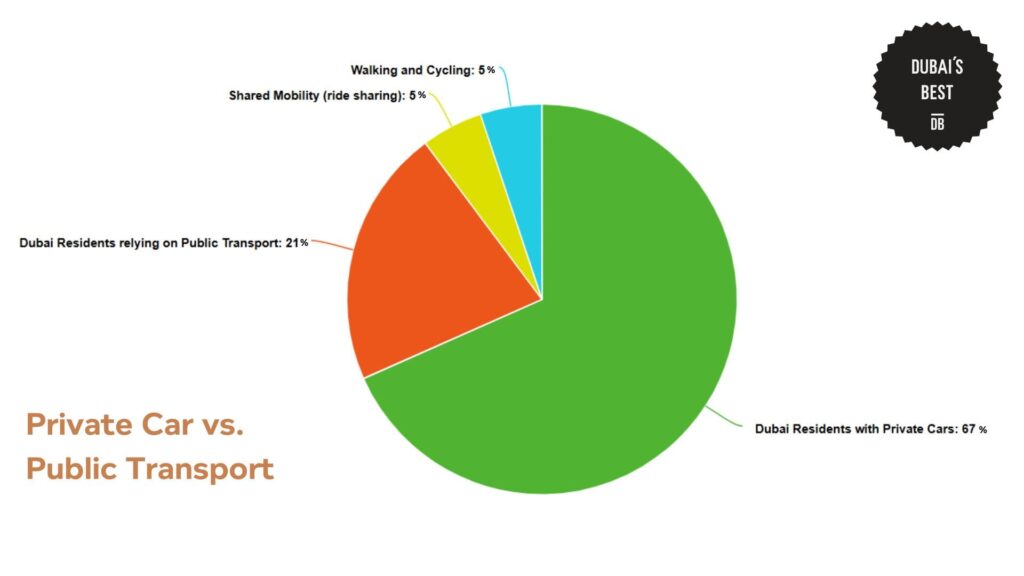
Certain areas can have metro and bus lines, which still make people prefer cars over such options, and this is the one reason for so much traffic congestion.
Public transport use is increasing, with the metro helping with the switch. Adding in shared mobility options may potentially help ease commute time and congestion through further expanded metro and bus routes.
Nonetheless, the high rate of car ownership leads to a high degree of traffic congestion, notwithstanding the efficiency of public transport.
Most residents prefer the flexibility and convenience offered by private vehicles, whereas the ongoing expansion of the metro and bus networks aims to encourage everyone to switch from private to public transport.
Public Transport in Dubai
The main public transport system of city Dubai incorporates the metro, tram, buses, monorail, and water transport, all of which are managed by the Roads and Transport Authority (RTA).
As of today, cars registered in Dubai are increasing from 1.9 million in 2021 to 2.27 million in 2023, contributing to traffic congestion, which continues to pose a challenge between car dependence and the expansion of public transport.
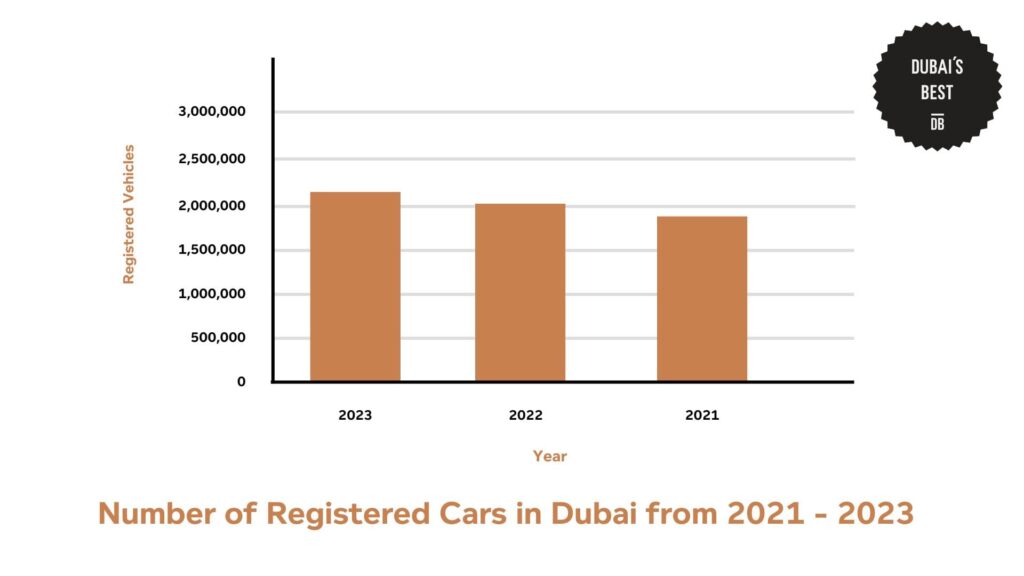
The number of taxis has increased to 12,532 in 2023 from 10,845 in 2021, while ridership has grown to 198.4 million. The increase in trips reflects taxis’ important role in the transport network of the city, alongside metros and buses.
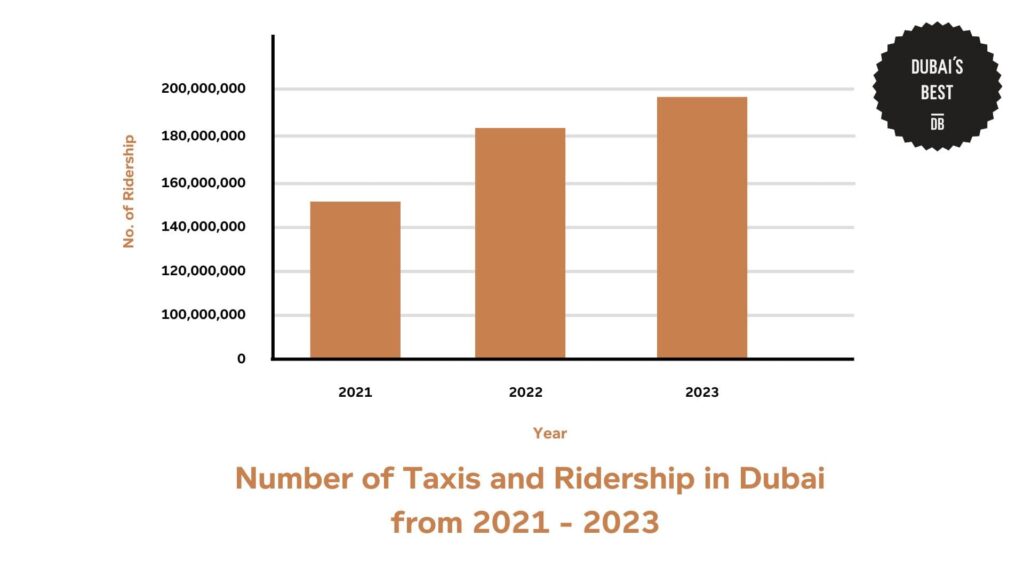
On the other hand, public bus ridership in Dubai appreciated significantly and was increased to reach 173.4 million passengers in the year 2023 from 157.2 million in the year 2022. With a heavy public bus network, it records 159 million riders on 170 routes.
Demand for intercity buses has also increased, moving up to 14.1 million passengers on 13 routes. The ever-growing lines and fleet size prove the city of Dubai’s growing commitment towards improving public transport accessibility.
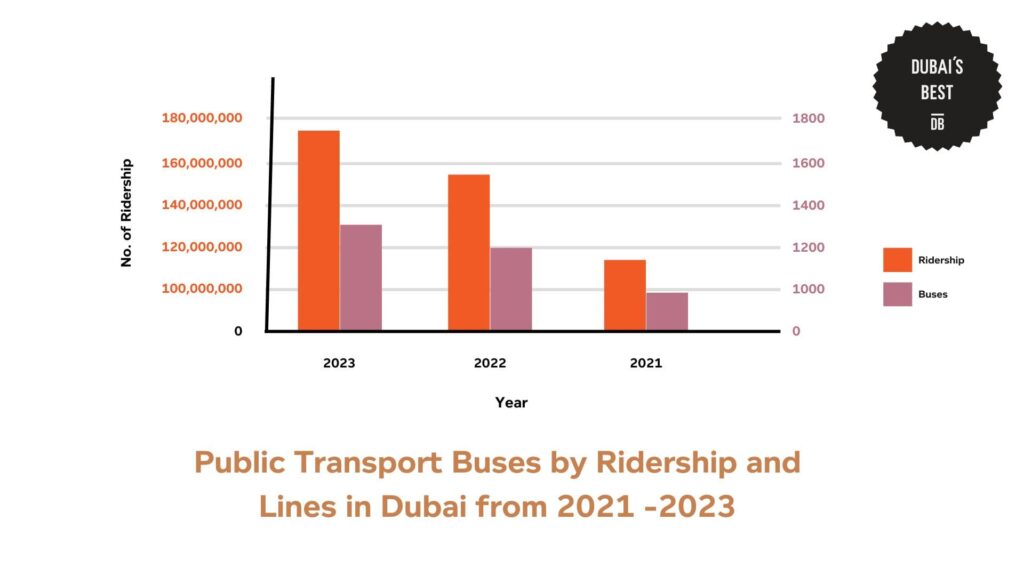
In general, steady growth is reflected in the public transport ridership of the emirate, which reached 503.3 million passengers in 2023, compared to 438.3 million in the previous year, 2022.
Metros are the most popular transport modes, carrying 260 million passengers in 2023 while buses transported 173 million passengers within the half-year period.
Shared mobility, marine transport, and tram mode also increased in ridership, showing that more residents are starting to take the public transport.
This was yet another achievement demonstrating the determined efforts made by the Emirates in reducing congestion and enhancing connectivity.
Private Transport and Car Usage in Dubai
The UAE has a high number of cars, with 343 vehicles for every 1,000 people, making it one of the top countries in Asia in terms of car ownership. This shows how common and accessible cars are in the country.
Japan ranks the highest in Asia, with 612 vehicles per 1,000 people, while the UAE remains among the top 10. This reflects the strong demand for personal vehicles in both nations.
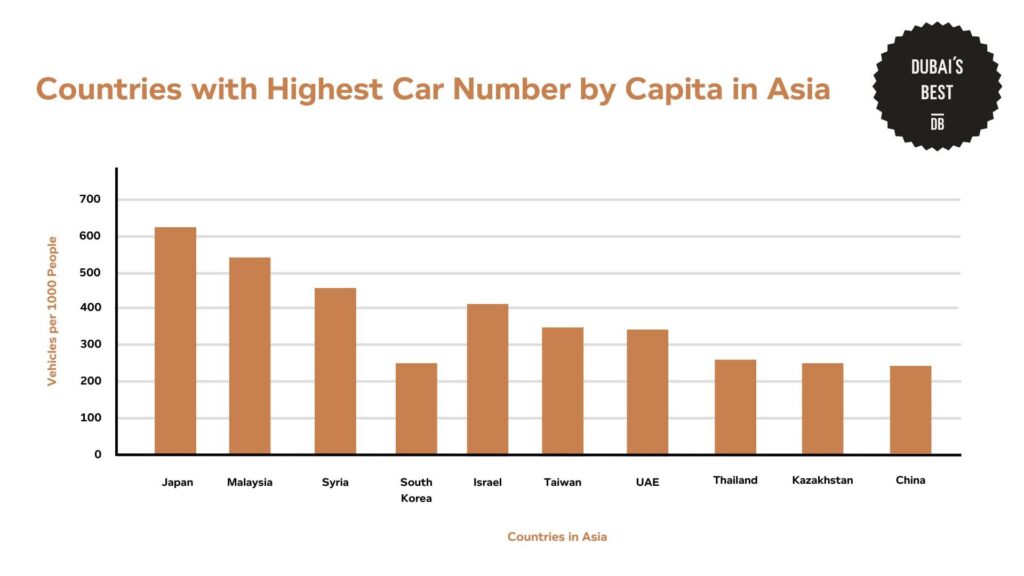
Mid-size cars (21%) and compact SUVs (17%) remain most common vehicle types in the UAE, offering that perfect blend of comfort and utility.
Least common, of course, are smaller vehicles, in the form of sports cars, microcars, and pickups, each representing only 2% of what rolls against the larger sea of mid-sized cars and compact SUVs.
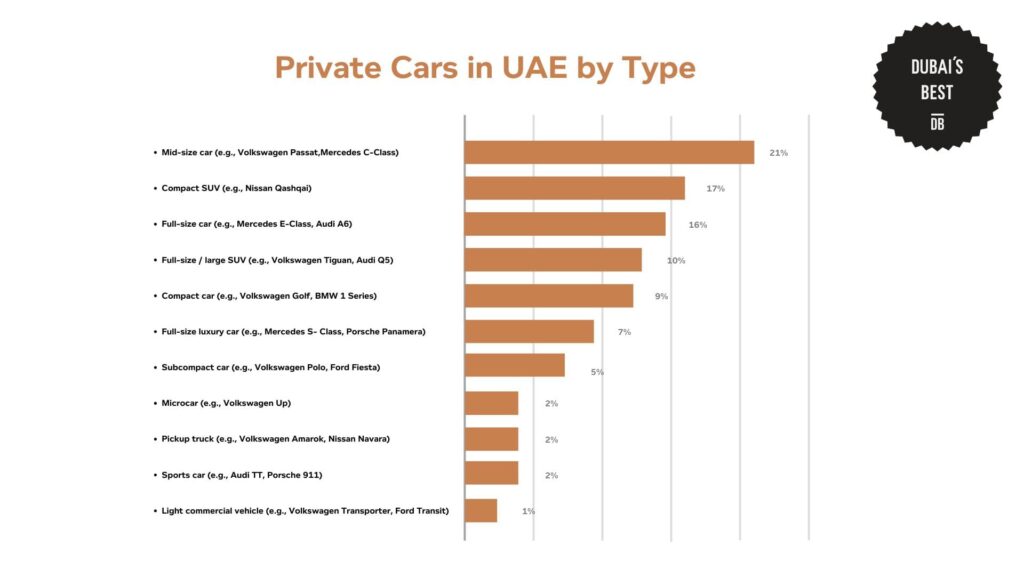
Anything larger than that, like minibuses and vans, is rare, less then 1%, save for 5% “Other” and 1% uncertainty. In fact, mid-size cars and compact cars ranked mostly among the best choices since they provide excellent performance and are hugely convenient.
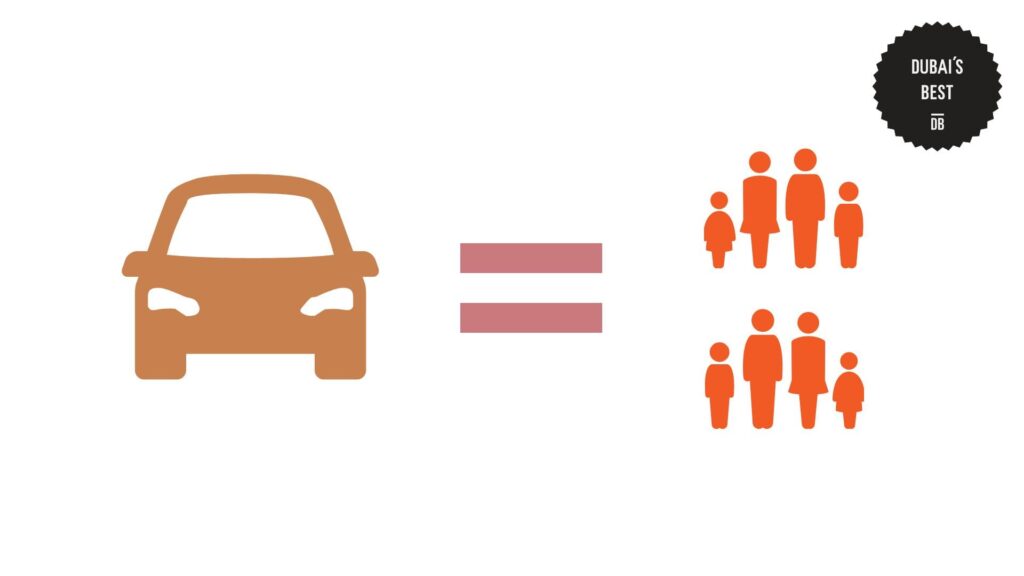
Dubai accounted for 40% of the 3.5 million cars in the UAE last year, confirming its status as the leading city for car ownership in the country.
In 2018, the number of cars per 1000 population was 540, so the percentage of adult people keeping their own car is more than 50%.
It is important to understand why the fleet is so high because cars have become a part of Emirate way of life. It will be argued personal vehicles still enjoy popularity in Dubai thus serve as a major travel mode.
Traffic and Congestion in Dubai
According to the Inrix 2023 Global Traffic Scorecard, Dubai drivers lose 35 hours per year due to traffic delays, making it one of the most congested cities in the Gulf.
Riyadh follows closely with 34 hours, while Abu Dhabi (19 hours) and Singapore (20 hours) have the least delays on the list.
In Asia, Istanbul tops the ranking with 105 hours, followed by Jakarta (89 hours) and Bangkok (74 hours), highlighting severe congestion in these cities.
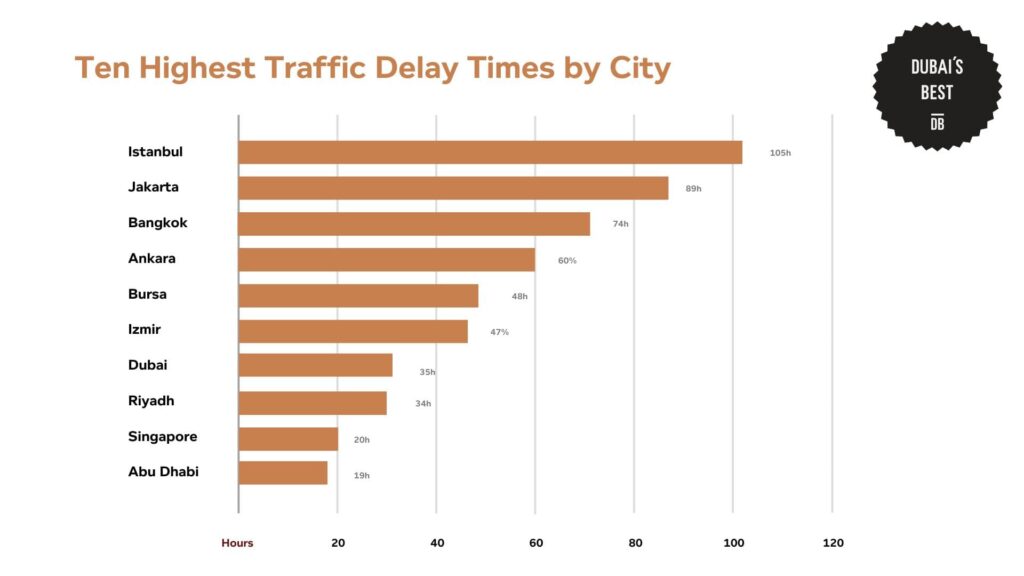
Dubai experiences its busiest traffic during weekday peak hours, with the morning rush from 6:30 AM to 8:30 AM as commuters head to work and school. The evening rush runs from 5:30 PM to 8:00 PM, with heavy congestion as people return home.
The worst traffic happens between 4:00 PM and 7:00 PM, when roads are most crowded. This period overlaps with both early evening commuters and post-work travel, making it the most challenging time to drive.
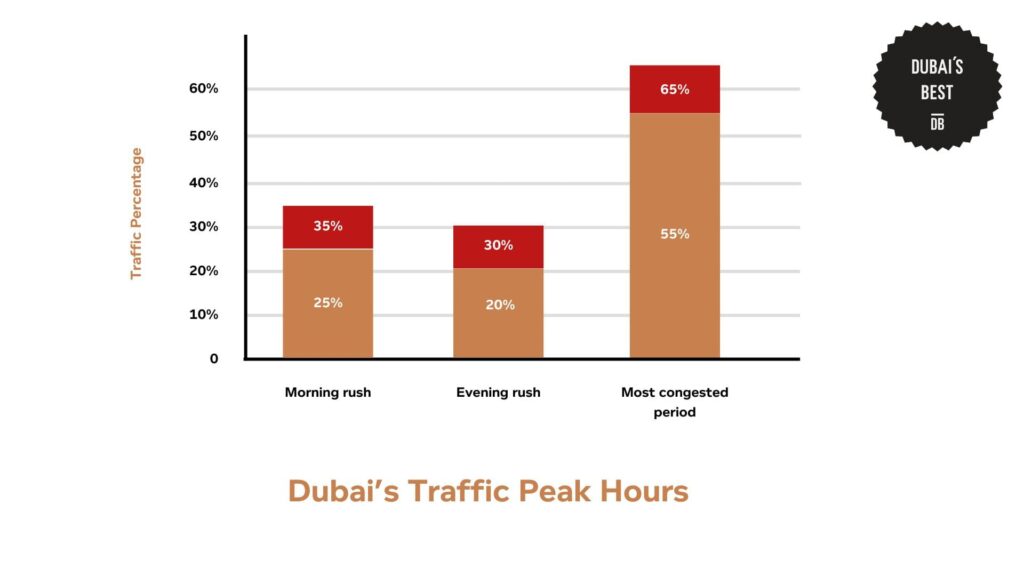
Commuting Costs: Public vs. Private Transport
Dubai transport services come at an affordable cost with the metro offering single ride rates ranging from AED 3-4 per zone and a monthly rate costs AED 260.
The Red Line travels from Rashidiya up to Jebel Ali Port stretch while the Green Line goes from Etisalat to Creek. In buses, the NOL card reduces the cost of connections for two hours from the first issuance of the card.
There will be an initial charge of AED 5 from the meter (in some cases, AED 25 from the airport) and then the fare is approximately from AED 10 to AED 50 per trip. Rental cars can be hired at AED 30-50 per day for easy transport within and outside of Dubai.
The NOL card can be purchased at either the metro stations or bus stops to enjoy the social transport system provided by Dubai at a reduced charge.
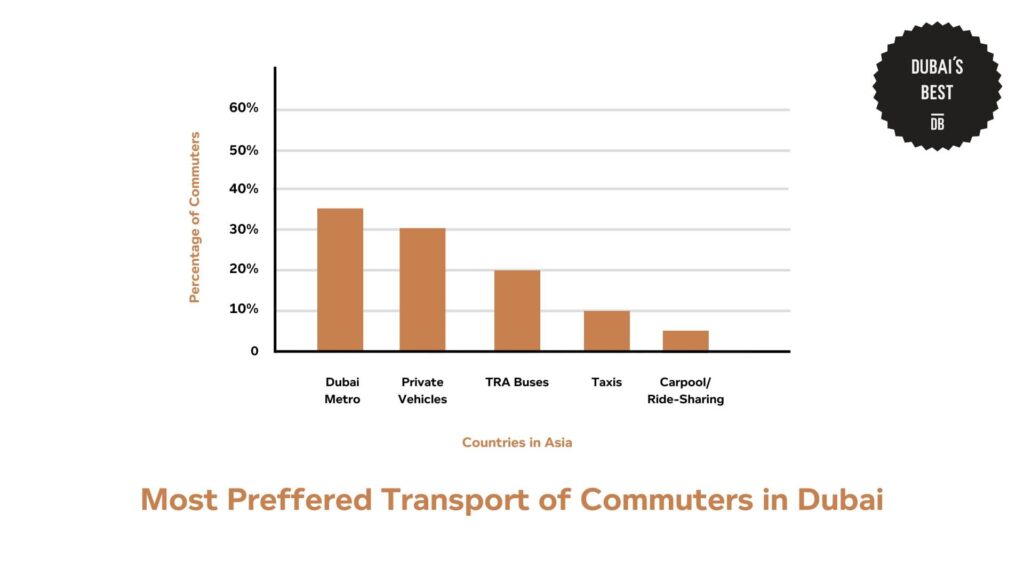
With these costs, The Dubai Metro (35%) is the top choice for commuters, with fares AED 4–8.5, followed by private vehicles (30%) and RTA buses (20%) at AED 3–7.5. Taxis (10%) are pricier at AED 35–80, while carpooling (5%) is the least used. Public transport, especially the metro, dominates daily travel in Dubai.
Sustainable Transport and Green Mobility in Dubai
The RTA aims for zero-emission public transit by 2050, following a phased approach. By 2030, no municipal waste will go to landfills, and by 2040, all taxis and limousines will be zero-emission.
By 2045, near zero-energy buildings will support sustainability, leading to fully zero-emission public buses by 2050. This phased approach ensures a greener future for Dubai’s transport system.
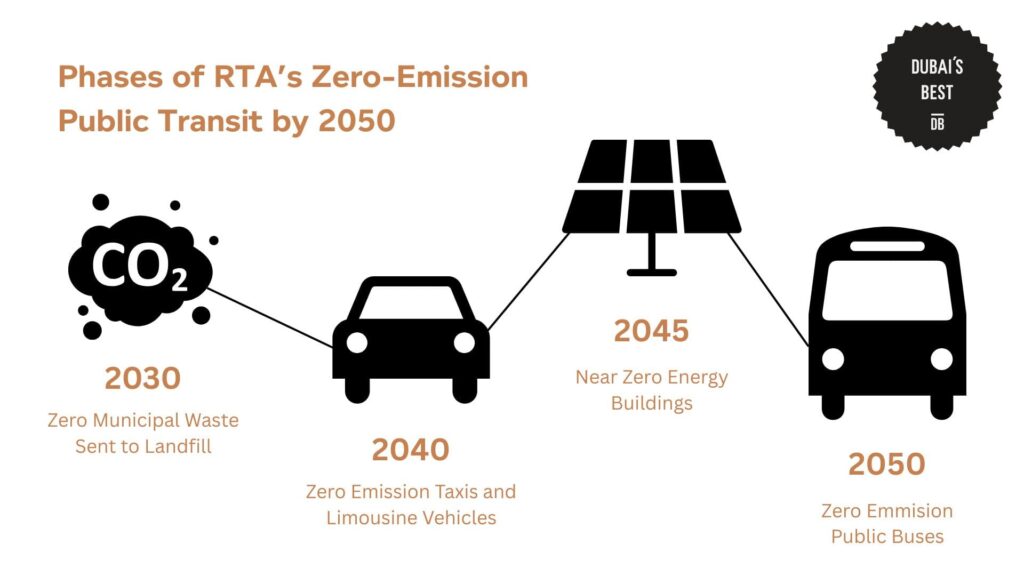
Currently, RTA has launched 43 energy and green economy initiatives to promote sustainability and reduce environmental impact. These efforts focus on cleaner transportation and energy efficiency.
As a result, the RTA has prevented nearly 201,000 tons of carbon dioxide emissions, significantly reducing its carbon footprint and supporting Dubai’s green goals.
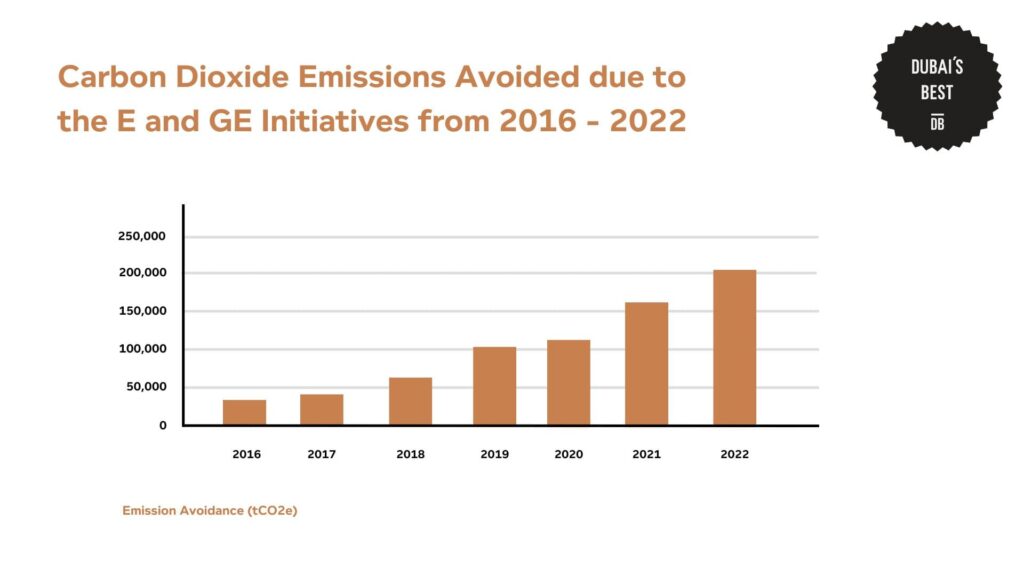
Also, for the same effort of the RTA, they were able to prevent nearly 4 million tons of CO₂ emissions from 2016- 2022.
Emissions reductions ranged from 575,000 tCO2e in 2016 to 755,963 tCO2e in 2022, with a peak in 2018 (642,000 tCO2e). A drop occurred in 2020 and 2021, likely due to pandemic-related travel changes.
This clearly shows the environmental benefits of increased public transport use and the sharp rise in 2022 suggests a strong return to public transit, reinforcing its role in Dubai’s sustainability efforts.
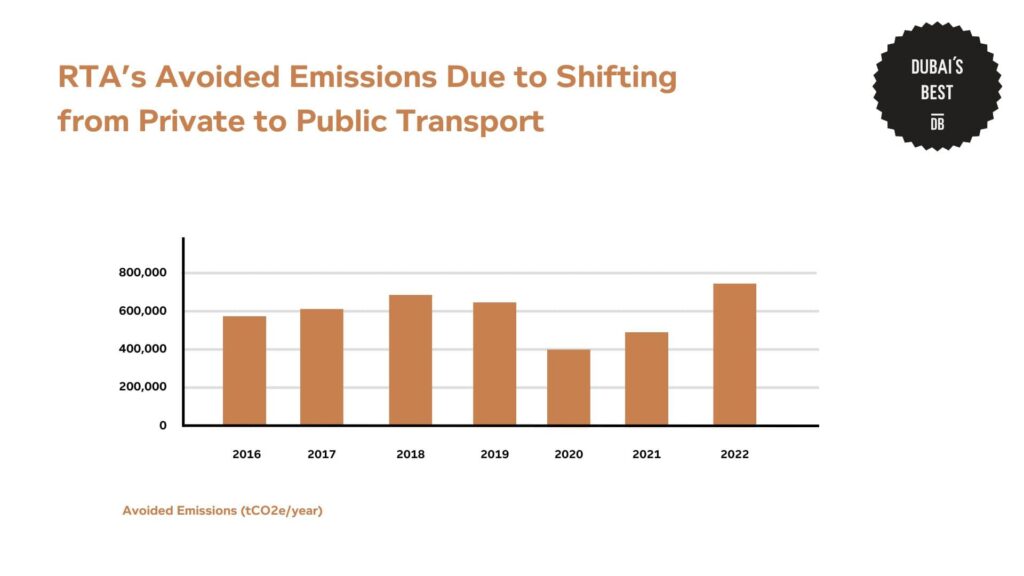
Future of Dubai’s Commuting
In 2022, Dubai’s RTA’s implementation of the 43 Energy and Green Initiatives, it has achieved significant resource savings.
They have conserved 86 million kWh of electricity, 50 million liters of petrol, and 2 million liters of diesel, reducing overall energy consumption.
Additionally, 275 mega liters of water have been saved, reflecting efforts toward environmental conservation.
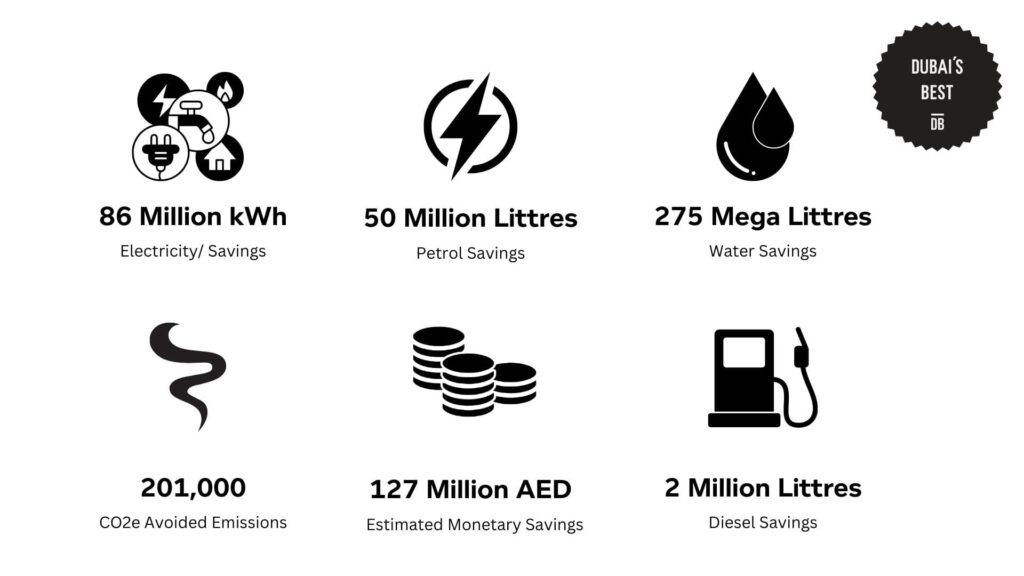
As part of this effort, Dubai is also set to make public transport emissions-free by 2050, the RTA plans to convert 100% of Dubai’s taxis to eco-friendly vehicles by 2027.
So far, 72% of taxis (8,221 hybrid vehicles) have already been transformed, exceeding the initial 50% target and cutting carbon emissions by 420,000 tons annually.
And as of December 2023, Dubai had 25,929 electric vehicles (EVs). This is a significant increase from 2022, when there were 15,100 EVs.
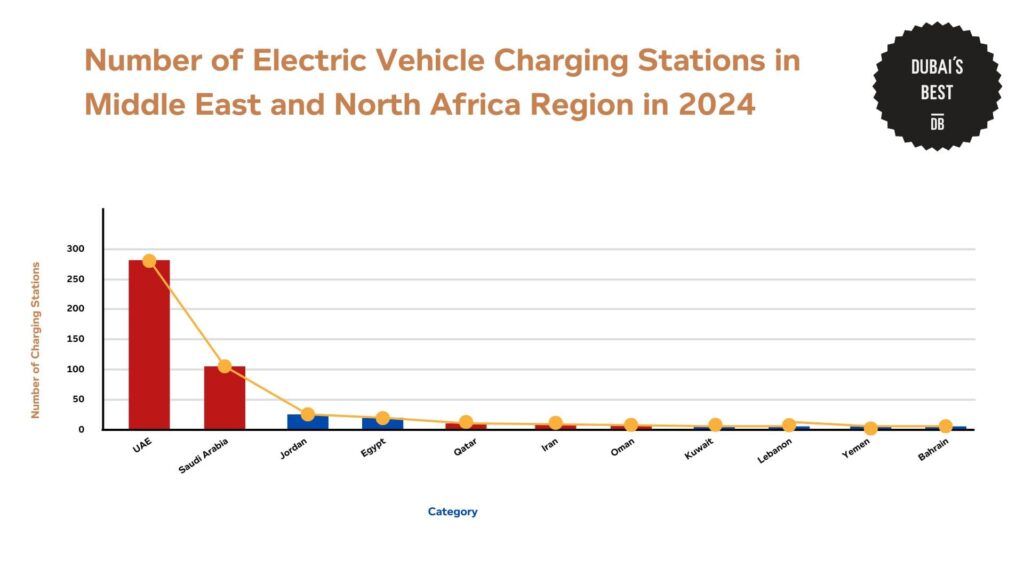
And if we look at the number of EV charging stations in the various Middle Eastern countries, the UAE tops the list with 261 stations, followed by Saudi Arabia with 101 and Jordan with 38.
And within the UAE, Dubai leads with 199 stations, far ahead of Abu Dhabi (28) and Sharjah (11). Other emirates, such as Fujairah and Ajman (5 each), Eastern and Western Regions (4 each), and Ras Al Khaimah (2), have fewer charging points.
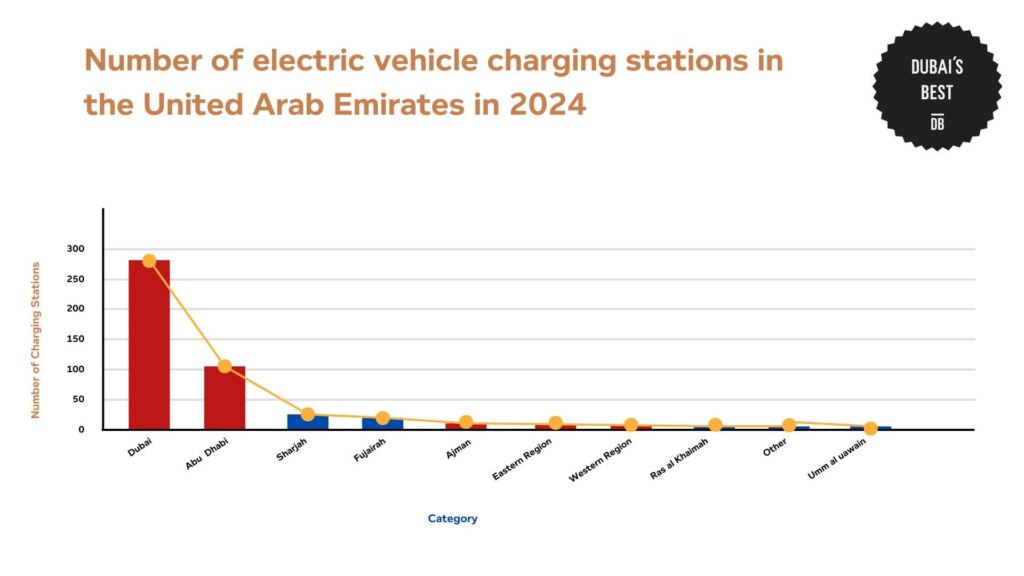
This distribution highlights Dubai’s strong push for EV adoption, positioning it as the regional leader in sustainable mobility.
References
- Agoda. (n.d.). How much does a trip to Dubai really cost? Your comprehensive budget guide. Retrieved from https://www.agoda.com
- CITA EV Charger. (n.d.). UAE electric vehicle market size. Retrieved from https://citaevcharger.com
- Dubai Statistics Center. (2023). Dubai Statistical Yearbook 2023. Retrieved from https://www.dsc.gov.ae
- Expatica. (n.d.). Buying a car in the UAE: What you need to know. Retrieved from https://www.expatica.com
- INRIX. (2023). Global traffic scorecard. Retrieved from https://inrix.com
- Invest in Dubai. (n.d.). Dubai public transport guide. Retrieved from https://www.investindubai.gov.ae
- Khaleej Times. (n.d.). There’s one car for every two residents in Dubai. Retrieved from https://www.khaleejtimes.com
- RTA. (2022). Sustainability Report 2022. Retrieved from https://rta.ae
- Statista. (2024). Car by type in the UAE. Retrieved from https://www.statista.com
- Statista. (2024). Dubai number of public transport rides by type. Retrieved from https://www.statista.com
- Statista. (2024). Duration of daily commute in the UAE. Retrieved from https://www.statista.com
- Statista. (2024). EV charging stations in MENA region by country. Retrieved from https://www.statista.com
- Statista. (2024). EV charging stations in the UAE by region. Retrieved from https://www.statista.com
- Time Out Dubai. (n.d.). Dubai traffic scorecard. Retrieved from https://www.timeoutdubai.com
- Trade.gov. (n.d.). UAE smart and sustainable mobility. Retrieved from https://www.trade.gov
- Transport Geography. (n.d.). Average commuting time. Retrieved from https://transportgeography.org
- Voronoi App. (n.d.). Who owns the most vehicles per capita by country? Retrieved from https://www.voronoiapp.com
- Visa Europe. (n.d.). Dubai city guide: Traffic and transport. Retrieved from https://www.visaeurope.lu
- Zoe Talent Solutions. (n.d.). Most preferred modes of traveling to work for people in Dubai. Retrieved from https://zoetalentsolutions.com





